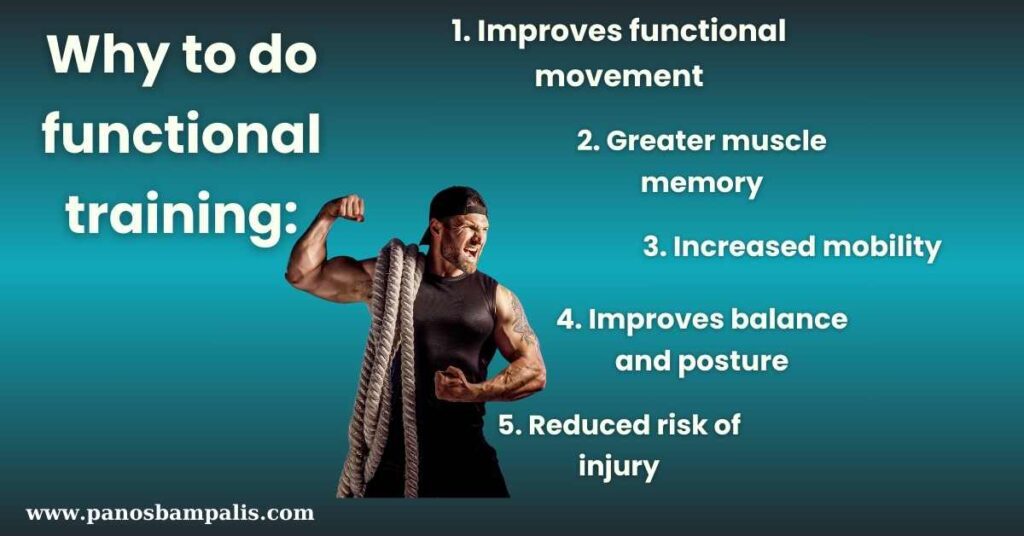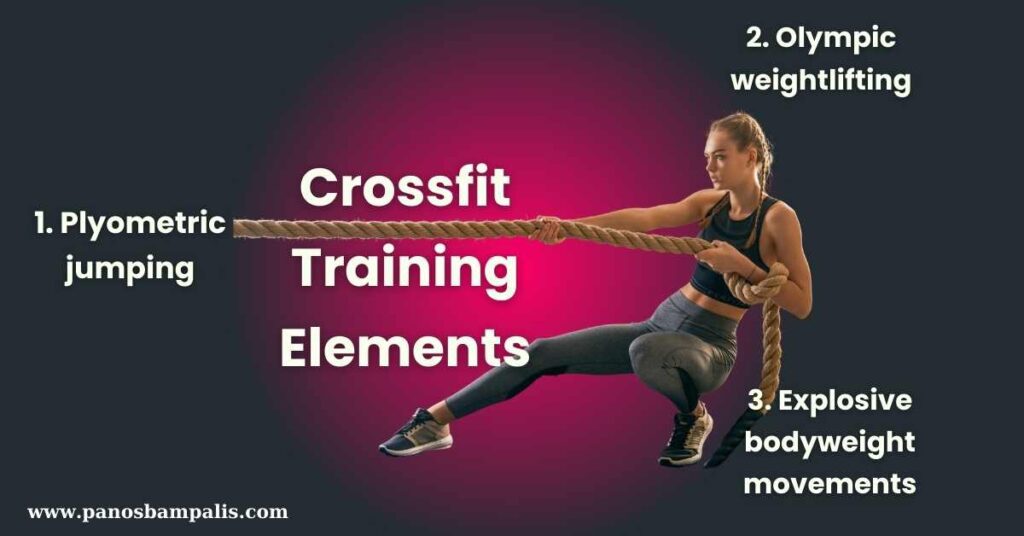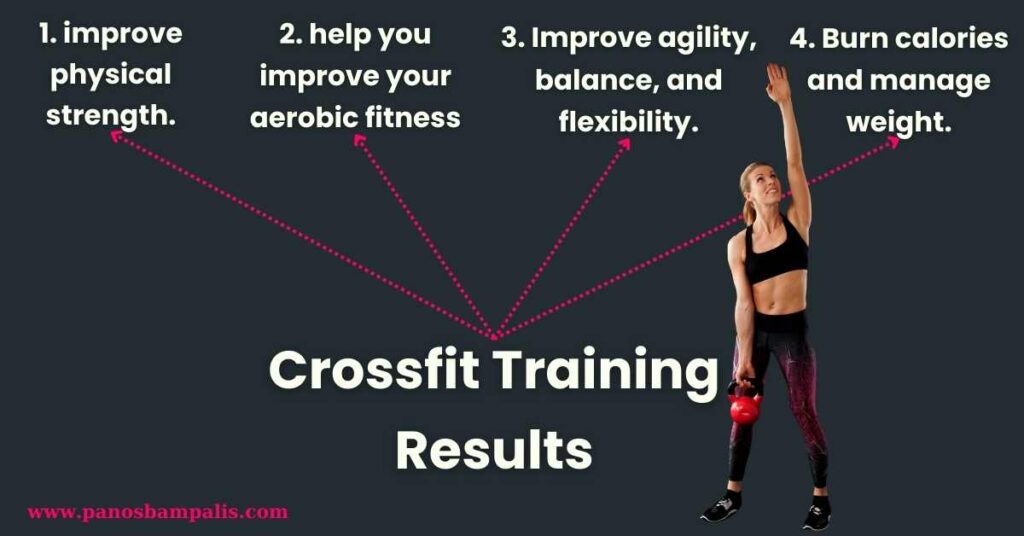Functional training. CrossFit. You’ve probably heard these terms thrown around your gym.
But do you know what functional fitness really is?
And how is it different from CrossFit?
If you need clarification about the type of training that’s best for your physical fitness goals, I feel you.
When I first started working out, I had no idea what people meant by “functional.” It sounded vague, like a marketing buzzword.
But functional training is so much more than that.
⚡TL;DR – Functional Fitness vs CrossFit

In this post, I’ll explain briefly what functional fitness is, how it differs from CrossFit, and why it is the most effective workout method for you.
Does spending less time exercising but seeing better results sound good to you?
Then, you need to know the truth about functional training and how it can transform your fitness routine.
Let me explain…
What is functional training?
Functional training is a workout method that focuses on improving how your body moves as a whole.
This type of training targets multiple muscle groups at once using bodyweight skills and exercises that mimic real-life movements.
Read below for the important benefits of functional training!
Instead of only doing bicep curls to isolate your arms or leg extensions to target quads, functional training uses integrated exercises like squats, lunges, push-ups, and pull-ups.
Have you heard about them? Sure you have…
These full-body moves train your muscles to work together and build total body coordination, mobility, and muscle memory.
The goal is to give you strength and agility for daily activities, from lifting boxes to getting up off the floor. It’s an effective way to train your whole body in an integrated way for real-world fitness. This primes your muscles for life’s unpredictable physical challenges.
Why do functional training?
Let me ask you this: Have you ever struggled to lift a heavy box or get up from the floor?
Those routine activities can be super complicated if you don’t have functional fitness. No matter your current fitness level, functional training gives you strength and mobility for real life.

These workouts target your weaknesses to improve how your body moves as a unit. Let’s see some benefits of functional fitness training:
Improves functional movement
Functional fitness training leads to better endurance and coordination by training multiple muscles together.
For example, squats don’t just work your legs. They engage your core and other muscles to stabilize your body.
This whole-body approach builds the bodywide endurance you need to squat, bend, or lift day to day efficiently.
You should remember that better bodyweight endurance means moving better!
Greater muscle memory
Ever notice how repeating an activity makes it feel more natural?
That’s muscle memory in action.
A good functional training program ingrains proper movement patterns through repeat full-body exercises.
Your muscles learn how to contract together for real-world tasks. The result is intuitive strength and agility gained from muscle memory.
Increased mobility
Functional training draws from gymnastics and calisthenics with moves like lunges that take joints through complete ranges of motion. This promotes mobility, which is often missing from other types of fitness training.
You’ll gain flexibility along with strength from the dynamic stretches involved.
It sounds crazy, right?
But that is one of the profound benefits of proper training. You may not become like the athletes in gymnastics, but consistency with the functionality will reward your body!
Improves balance and posture
Mastering a variety of functional movements requires whole-body coordination.
You must stabilize muscles throughout your body to do a proper squat or lift. This control boosts your balance. Using full motion builds core and back strength for good posture.
Ask yourself: How often have you specifically trained for balance and good posture?
Like you, I used to neglect these aspects of training. Be aware of those types of exercise. They are far more vital than you have heard in gyms.
Reduced risk of injury
Do you like bodybuilding training? Probably, you shouldn’t!
Isolated strength training can create muscle imbalances that strain joints.
On the contrary, functional training exercises develop balanced strength to make muscles work together. This reduces uneven stresses for better joint stability.
And it gets better…
You’ll build muscle strength in a way that supports movement and prevents injury.
What is CrossFit Training?
CrossFit is a type of high-intensity training program focused on improving overall fitness. The workouts combine different types of relentless functional exercise to boost endurance, strength, and mobility.
CrossFit aims to build competence across broad time and modal domains for complete fitness.

What does a CrossFit workout include?
CrossFit blends various functional movements and training styles for maximum intensity. You’ll do Olympic weightlifting, gymnastics, sprints, and more.
The combinations constantly challenge strength, speed, and skill in every workout. So, let’s see some exercise aspects of CrossFit:
Plyometric jumping
Plyos, like box jumps, pack huge benefits into short burst intervals.
Jumping builds explosive power and torque for greater strength and speed. Plyometric training pushes your fast-twitch muscle fibers for quickness.
Olympic weightlifting
Olympic lifts like the snatch and clean & jerk build tremendous strength and endurance.
These full-body compound exercises train power production and capacity with heavy resistance.
Explosive bodyweight movements
Burpees, push-ups, pull-ups.
Challenging exercises. Right?
These explosive bodyweight moves crank up intensity. The focus is using your weight forcefully and quickly to drive your heart rate up and strength forward.
Why do CrossFit training?
CrossFit is a targeted training method using constantly varied, high-intensity workouts to improve fitness.
This type of cross-functional approach provides broad conditioning benefits quickly. CrossFit builds strength, endurance, and mobility through full-body functional movement.

It may improve physical strength.
The focus on heavy compound lifts like deadlifts and squats drives muscular power. CrossFit workouts frequently include Olympic weightlifting, which builds tremendous strength through complete range resistance.
It may help you improve your aerobic fitness.
The intense interval-style training of CrossFit enhances cardiovascular fitness. Maintaining high intensity through varied movements and weights spikes heart rate and boosts VO2 max.
Improve agility, balance, and flexibility.
CrossFit develops agility and control by requiring coordination through rapid, complex moves. Switching from lifts to gymnastics to sprints trains balance. And the range of motion improves through full functional patterns.
Burn calories and manage weight.
The nearly nonstop efforts of CrossFit workouts burn significant calories. Using multiple large muscle groups sustains high-calorie burn. The combination of resistance and cardio training torches fat for weight loss.
What are the differences between functional training and CrossFit?
While CrossFit and functional training have overlap, they are not identical.
The goal is to develop strength, mobility, and balance for life’s demands.
The programming aims to improve fitness across broad time and modal domains by constantly varying functional exercises performed relentlessly.
Why adopt a functional fitness training mindset?
We live in an inactive world of screens and chairs.
But our bodies evolved for movement – walking, bending, running, jumping. We lose functionality by not regularly using full ranges of motion.
A functional training mindset recognizes our body is meant for action, not restriction. So the priority becomes reclaiming strength, mobility, and muscle memory through natural, multi-joint movements.
Rather than only aesthetic goals like bigger biceps, the purpose is to pursue practical fitness. Well-rounded athleticism makes your body work better on a day-to-day basis, whether it’s lifting luggage or playing with kids.
Functional training ensures your physical abilities stay strong. You become capable and resilient.
Functional Fitness vs CrossFit: Summing Up
When choosing between CrossFit and functional training, the best option is to incorporate both.
Functional training provides a framework for building overall athleticism through natural movement patterns that enhance real-world strength, balance, and mobility. This trains your body to work as an integrated unit.
CrossFit offers intense, varied workouts that push your fitness to new levels across broad modalities. The combination of heavy compound lifts, gymnastics, and sprinting takes your endurance, power, and agility to the edge.
While CrossFit works within the functional training philosophy, its programming aims to maximize your general physical preparedness through relentless intensity.
Blending hard-hitting CrossFit sessions with skill-honing functional training gives you the best of both worlds – all-around fitness to overpower daily demands and destroy any challenge life throws your way.
The sweet spot is training functionally with high intensity.
FAQ: Is CrossFit the same as functional fitness?
1. What is the difference between CrossFit and functional fitness training?
CrossFit and functional fitness training are often used interchangeably, but subtle differences exist. CrossFit is known for its high-intensity functional movements and varied workouts, while functional fitness training focuses on improving overall fitness levels through functional movements that mimic everyday activities.
2. Can anyone participate in CrossFit or functional fitness training?
CrossFit and functional fitness training can be tailored to accommodate different levels of physical fitness. Finding a certified CrossFit trainer or functional fitness coach who can adapt the program to individual abilities and goals is essential.
3. How do CrossFit and functional fitness training differ in their approach to workouts?
CrossFit is characterized by mixed modal training, incorporating a variety of functional movements and high-intensity interval training.
On the other hand, functional fitness training may include a more comprehensive array of exercises, focusing on whole-body movements and extensive training to enhance overall fitness.
4. Are there any specific aspects of CrossFit that set it apart from functional fitness training?
CrossFit has gained recognition for its competitive nature, with participants engaging in CrossFit workout routines and often competing in international functional fitness federation events. While functional fitness training emphasizes competition, it simulates real-life activities through various functional movements.
5. What are the main trends in exercise science that influence CrossFit and functional fitness training?
Exercise science and practice have significantly influenced both CrossFit and functional fitness training, leading to an increase in the popularity of high-intensity functional training and the integration of different levels of physical.

